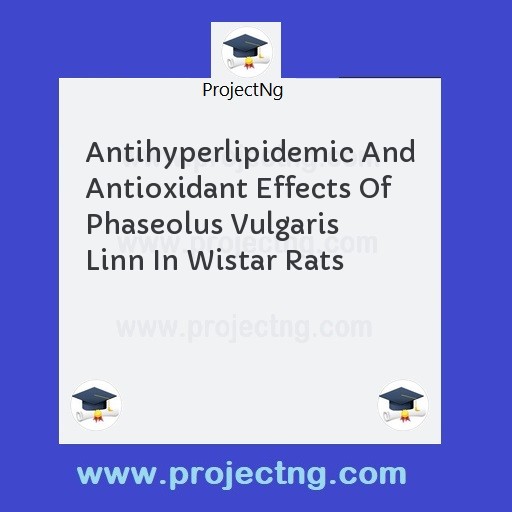Antihyperlipidemic And Antioxidant Effects Of Phaseolus Vulgaris Linn In Wistar Rats
Pharmacy Project Topics
Get the Complete Project Materials Now! »
ANTIHYPERLIPIDEMIC AND ANTIOXIDANT EFFECTS OF
PHASEOLUS VULGARIS LINN IN WISTAR RATS
ABSTRACT
In this study, the antihyperlipidemic and antioxidants activities of the extract and fractions of
Phaseolus vulgaris L. were evaluated. The crude extract (PVE) of dried pulverized plant material
was obtained by maceration in methylene chloride/methanol (1:1) while the solvent fractions
were obtained by successive solvent-solvent partition in separating funnel between the crude
extract suspended in aqueous medium and solvents of increasing polarity to obtain the n-hexane
fraction (PVHF), ethylacetate fraction (PVEF), and butanol fraction (PVBF) in that
order.Antihyperlipidemic effects of the extracts and fractions were investigated using acute, subacute
and chronic models. In all threemodels, treatment with (PVE) caused significantreduction
(P<0.05) in the lipid profile parameters with the most significance seen in the sub acute study
where total cholesterol was decreased by 38.44%. Triglycerides level was significantly decreased
(P<0.05) by 18.18% in the acute study model.Similarly, very low density lipoprotein (VLDLC)
and low density lipoprotein (LDL-C) wasrespectively decreased by 18.18% and 48.73% in the
acute antihyperlipidemia model. In contrast, high density lipoprotein (HDL-C) level was
significantly (P<0.05) increased in the acute phase by 20.85%.In all study protocols involving
the various fraction there were significant increase(P<0.05) in lipid profile. PVEF (400 mg/kg)
produced- the most significant reduction in total cholesterol level in the acute study with
percentage decrease of 22.10% compared to the control treatment. Triglycerides level was
similarly reduced by 21.59% and 15.91% at PVHF (200 mg/kg) and PVEF (200 mg/kg) with the
acute study.The sub-acute protocol showed significant decrease at PVBF 200 mg/kg percentage
decrease of 17.28%. VLDL-C level for the fraction study showed significant decrease (P<0.05)
at PVHF 200 mg/kg and PVEF 200 mg/kg with percentage decrease of 21.59% and 15.91%
during the acute protocol, the sub-acute protocol showed significant decrease at PVBF 200
mg/kg percentage decrease of 17.28. LDL-C level for fraction extract study showed dose
dependent significance decrease (P<0.05) seen at PVHF 100 mg/kg, PVEF100 mg/kg, and 200
mg/kg with percentage decrease of 47.19%, 41.62% and 53.39% respectively during the acute
protocol, Finally in the chronic protocol a significant decrease was seen with PVHF 200mg/kg,
PVEF 100 mg/kg, and PVBF 200 mg/kg with percentage decrease of 26.03%, 24.82% and
20.05% respectively. HDL-C level for extract study showed dose dependent significant increase
(P<0.05) seen at PVHF 100 mg/kg, PVEF 100 mg/kg and 200 mg/kg with percentage increase
of 30.44%, 28.88% and 30.86%. DPPH reduction and nitric oxide scavenging assays were used
in the investigation of the extract and fractions for the in vitro antioxidant activities study, the
antioxidant activities of the extract and fractions were further determined in vivo in rats.
Antioxidant enzymes and factors such as catalase, glutathione peroxidase, and lipid peroxidation
activities were measured in carbon tetrachloride-treated rats treated with or without the extract
and fractions studies. The highest percentage reduction of DPPH was 80.61% seen with PVEF
and PVBF fraction at 400 mg/kg. The highest percentage reduction of nitric oxide was 75.86%
seen with PVHF at 200 mg/kg. The in vitro study showed significant increased (P<0.05)
scavenging activity with the PVHF and PVEF having scavenging activity comparable with
ascorbic acid. In in-vivo antioxidant assay showed that the Lipid peroxidation levels estimated by
thiobarbituric acid reaction showed no significant (P>0.05) increase or decrease in the serum
MDA of both the treated and untreated group, while in catalase activity estimation showed
significant (P<0.05) increase was seen with PVE 100 mg/kg of 71.05%, Glutathione peroxidise
activity showed the most significant percentage (P<0.05) increase of 76.19% for PVBF 100
mg/kg.The results of the study showed that the extracts and fractions of Phaseolus vulgaris
xiv
xiv
posses anti-hyperlipidemic and antioxidant with the PVEF showing better and more consistent
effects with all protocols used in the investigation.
1
CHAPTER ONE
1.0. INTRODUCTION
A large volume of scientific research suggests that in situations of oxidative stress, reactive
oxygen species (ROS) are generated and a homeostatic environment between anti-oxidant and
oxidation is created, which are known to be an important concept for maintaining
Be the First to Share On Social

Enjoying our content?
Don't miss out on new videos! Subscribe to our YouTube channel for more awesome content.
Subscribe Now!













